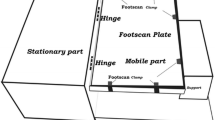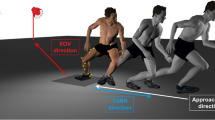Abstract.
We performed a gait analysis of 12 healthy subjects in order to analyse the rear foot pronation-supination angle and the shift of centre of pressure (COP) during walking. We used a video system and a force plate and examined the effects of semi-rigid Air-Stirrup brace, lace-up cloth RocketSoc brace, ankle taping and no bracing. Both the lace-up cloth brace and taping increased the maximum pronation angle during the stance phase. The lace-up cloth brace alone was associated with a larger maximum pronation velocity. With the lace-up cloth brace and taping, the COP was more laterally placed, allowing greater leverage about the subtalar axis and thus increasing the tendency toward pronation. The two braces and the tape did not similarly affect ankle joint biomechanics during gait. The ability to reduce excessive amounts of pronation is an important design consideration for prophylactic ankle supports.
Résumé.
Nous avons exécuté une analyse de la démarche de douze sujets sains pour analyser l'angle de pronation-supination de l'arrière pied et le changement de centre de pression pendant la marche. Nous avons utilisé un system de vidéo et une plaque de force et avons examiné les effets de l'attelle semi-rigide Air – Stirrup, de l'attelle en tissu à lacets de RocketSoc, du simple bandage en sparadrap et enfin d'aucune contention de la cheville. L'attelle en tissu à lacets et le sparadrap ont augmenté l'angle de pronation maximale pendant la phase de posture. L'attelle en tissu a été associée à une plus grande vélocité de pronation maximale. Avec l'attelle en tissu et avec le bandage, le centre de pression a été placé plus latéralement autorisant une plus grande puissance selon l'axe sous-astragalien et donc augmentant la tendance vers la pronation. Les deux attelles et le bandage n'affectent pas la biomécanique de la cheville pendant la marche de la même façon. La capacité de réduire une pronation excessive est une considération importante dans la conception des supports prophylactiques de la cheville.
Similar content being viewed by others
Author information
Authors and Affiliations
Additional information
Electronic Publication
Rights and permissions
About this article
Cite this article
Nishikawa, .T., Kurosaka, .M., Yoshiya, .S. et al. Effects of prophylactic ankle supports on pronation during gait. International Orthopaedics (SICOT) 26, 381–385 (2002). https://doi.org/10.1007/s00264-002-0362-4
Accepted:
Issue Date:
DOI: https://doi.org/10.1007/s00264-002-0362-4




